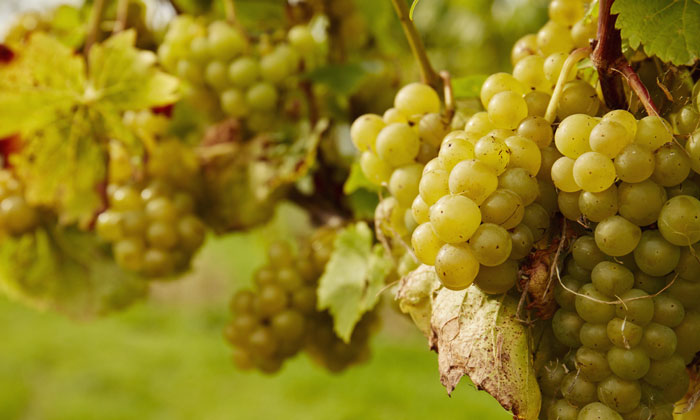England’s wine industry under the spotlight
- Like
- Digg
- Del
- Tumblr
- VKontakte
- Buffer
- Love This
- Odnoklassniki
- Meneame
- Blogger
- Amazon
- Yahoo Mail
- Gmail
- AOL
- Newsvine
- HackerNews
- Evernote
- MySpace
- Mail.ru
- Viadeo
- Line
- Comments
- Yummly
- SMS
- Viber
- Telegram
- Subscribe
- Skype
- Facebook Messenger
- Kakao
- LiveJournal
- Yammer
- Edgar
- Fintel
- Mix
- Instapaper
- Copy Link
Posted: 14 December 2017 | Jonathan Lloyd | Divisional Director | Lycetts | No comments yet
It’s been on the up for the last decade, but just how well is England’s wine scene performing at the moment? Lycetts, a specialist wine insurance provider, investigates.


SECOND CAREER: Grape waste could have a second life in other foods and in cosmetics.
Earlier this year, English winemakers warned that “catastrophic” damage had been caused to buds which had bloomed earlier than usual following air frost sweeping the country after a warm start to 2017. Fast forward to the end of the year though and the English wine industry is now going through a glorious period, says Jonathan Lloyd, Divisional Director at Lycetts, highlighted by a new study which suggested that the sector is now worth in excess of £130 million.
The scope of the English wine industry
English Wine Producers has provided a great insight into how bustling the English wine scene currently is with its latest statistics. According to the marketing arm of the UK’s wine industry, as of 2016 there were 503 commercial vineyards and 133 wineries throughout England and Wales. In 2015, these facilities — which have a total hectarage of over 2,000 hectares under vine — collectively produced an estimated 5.06 million bottles of wine.
Wineries and vineyards can be found all across England now too. There are 13 wine producing regions in Mercia, seven in East Anglia, another seven in the South West, six in the South East, five in the Thames & Chilterns area and four in Wessex.
“If you compare us as a wine-producing nation to most other regions in the world, we’re minuscule. But if you look at our rate of growth, we’ve more than doubled our hectarage in the last 10 years,” acknowledged English Wine Producers’ Julia Trustram Eve.
Variety is a particular appealing aspect of vineyards and wineries seen across England and Wales. Approximately 66 per cent produce sparkling wine, 24 per cent still white wine and the remaining ten per cent red or rosé wine. Further variety is seen when looking at the top ten grape varieties planted, which is based on 1,532 hectares of vineyards analysed:
- Chardonnay, which made up 23.06 per cent of production; a total area in commercial production of 353.37 hectares.
- Pinot Noir, which made up 22.01 per cent of production; a total area in commercial production of 323.14 hectares.
- Bacchus, which made up 8.39 per cent of production; a total area in commercial production of 128.52 hectares.
- Seyval, which made up 5.76 per cent of production; a total area in commercial production of 88.31 hectares.
- Pinot Meunier, which made up five per cent of production; a total area in commercial production of 76.65 hectares.
- Reichensteiner, which made up 4.72 per cent of production; a total area in commercial production of 72.35 hectares.
- Rondo, which made up 3.15 per cent of production; a total area in commercial production of 48.24 hectares.
- Muller Thurgau, which made up three per cent of production across a total area in commercial production of 45.94 hectares.
- Madeleine Angevine, which made up 2.57 per cent of production across a total area in commercial production of 39.34 hectares.
- Ortega, which made up 2.32 per cent of production across a total area in commercial production of 35.48 hectares.
It also must be mentioned that, according to English Wine Producers, a million vines are being planted throughout England and Wales in 2017. This will make it the largest planting achieved in a single year.
The growth of the English wine industry
In 2015/16, analysis by online business finance supermarket Funding Options revealed that independent English wine producers were successful in increasing their turnover to a record high of £131.9 million. This is a 16 per cent rise on the £113.8 million turnover which was recorded in 2014/15, as well as a considerable jump from the £55.7 million recorded just five years ago (2010/11).
Furthermore, HM Revenue and Customs statistics illustrated that 64 new wine producers were able to obtain a licence for wine production throughout 2016. That’s yet another record for the English wine industry.
“English wine is going from strength to strength,” reflected Funding Options’ founder Conrad Ford. He added: “The English wine industry is not only gaining traction amongst domestic consumers, but is now being ranked with wines from traditional white wine-producing countries such as France and Germany.
“Wine growers need to reduce restrictions on production and capacity to ensure consistent, sustainable growth in the long-term. The fall in the value of sterling serves to showcase exactly how producers need to be able to increase capacity to react quickly to changing market conditions.”
English wine which is award-winning
England is also now host to a variety of award-winning wine which claimed their honours by seeing off international competition.
At the Decanter World Wine Awards in May 2017, for instance, Winbirri Vineyards’ Bacchus 2015 wine collected the Platinum Best in Show prize to become the world’s best white wine. The Norfolk-based wine beat off competition from some 17,200 other entries and received a score of 95 out of 100 by a panel of 200 experts from across the globe.
Miles Beale, the Wine and Spirit Trade Association’s chief executive, commented: “It comes as no surprise to us that an English Bacchus wine has won a major international award. Up until now, English Sparkling Wine has been grabbing most of the headlines for its outstanding quality. It was only a matter of time before an English still wine showed the world it can also compete with the best.”
This isn’t the only prestigious award picked up by English wine over the past few years. In 2010, both the Camel Valley winery in Cornwall and Nyetimber in West Sussex were recognised at the 2010 International Wine Challenge — the former for its 2008 Pinot Noir Rose Brut and the latter with its 2001 Blanc de Blancs.
At the inaugural Independent English Wine Awards, Good Life Farm Shop was also awarded a Silver for its 2013 Blanc de Noirs wine. Then last year, East Sussex-based Sedlescombe Organic Vineyard’s 2015 Regent Rose was awarded the only ‘Top Gold’ medal at the 2016 International Organic Wine Awards.
How the England’s wine scene is changing
A major change is coming to the English wine industry though, but this is an alteration intended to move the industry forward both on domestic and international shores.
The move centres around a vote by both The United Kingdom Vineyards Association (UKVA) and English Wine Producers (EWP) in favour of the two bodies being merged to create a single-industry representative body. Named UK Wine Producers (UKWP), this organisation will now be tasked with promoting, representing and supporting every wine producer and vineyard found across the UK.
“We can now speak with a single voice, and can consult with a single membership, making it clearer to Government what the industry thinks,” stated Simon Robinson, owner of Hattingley Valley and the new chair of the UKWP, to Horticulture Week.
“The big issue now for us is Brexit. We want assurances that there will be no constraints on planting. In large parts of Europe, you can’t plant a new vineyard unless you take one out. We aren’t scouting for government support for production but would like support for sales and marketing, especially overseas, as other wine-producing countries do.”
To find out more about Lycetts’ specialist wine insurance, click here.
Sources:
https://www.fundingoptions.com/latest/press-releases/english-wine-industry-grows-16percent/
https://www.theguardian.com/money/2010/may/18/english-wines-win-gold-medals
http://www.goodlifefarmshop.co.uk/news.asp?contentID=615
https://www.englishorganicwine.co.uk/pages/english-wine-wins-top-spot-in-international-challenge
http://www.englishwineproducers.co.uk/background/stats/
http://www.englishwineproducers.co.uk/files/7014/6399/8219/Instant_Fact_Sheet_2016.pdf
http://www.englishwineproducers.co.uk/files/4714/6399/9245/August_2015_Vine_Variety_Data.pdf
http://www.hortweek.com/english-wine-continue-build-its-success/fresh-produce/article/1438722
https://www.thedrinksbusiness.com/2017/07/english-wine-industry-now-worth-132-million/
http://www.bbc.co.uk/news/uk-39792774









